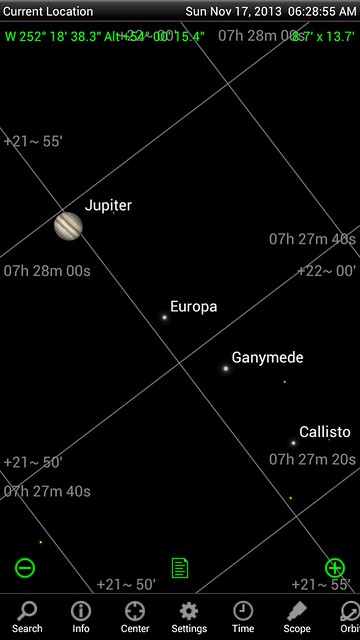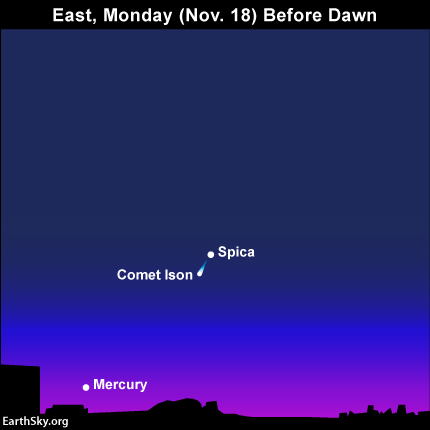Just as I was settling down and thinking about making my morning cup of tea, I thought I’d check the eastern sky one last time (see my earlier post about cloud cover on the wrong half of the sky). Surprise! The clouds disappeared, probably due to the wind advisory we’re still under. I could barely see the star Spica just breaking through the bare limbs of my neighbor’s trees.
I went back inside and grabbed my binoculars. I then headed to one of my east-facing second floor bedrooms. Thanks to my kids, the window in the south room has no screen so I can open it and have a clear view above my neighbor’s rooftops.
From 5:20 to 5:40 a.m. I spent time reviewing my Sky Safari sky atlas with Comet Ison centered. I had to adjust the number of visible stars by magnitude, down from 10.0 to 7.0, since I had to contend with light pollution, poor seeing conditions and a rapidly brightening eastern sky thanks to our local closest star. Then I adjusted the field of view to match my binoculars, straining to see any of the dim stars near Spica that would allow me to triangulate on Comet Ison. I finally spotted the faint comet, using averted vision.
At this point, I thought to get my telescope out of the basement. I’d replaced the battery in my red-dot finder scope and I could clearly see Spica, so I surmised I had a good chance of being able to find the comet. I didn’t bother to align the scope, which would have taken 5-10 minutes of rapidly diminishing darkness. I found Spica quickly and easily.
Then I had to re-learn how to navigate my telescope manually with my hand-held controller. The ETX-90’s field of view is upside down and reversed right-to-left so spacially it can be tricky to steer while staring through the eyepiece with one eye.
I found the comet, but it was still quite faint even through the telescope. I used 30mm and 26mm eyepieces and observed the comet for a few minutes. By this time, it was nearly six o’clock and I could see the sky paling. According to my Sky Safari app, Mercury had risen and Saturn would be rising soon as well, but I couldn’t see Mercury yet because it was still hidden behind the houses and trees.
Since I’d found the comet, I decided to look at one more solar system item before packing the telescope back to the basement. Almost directly overhead, at about one or two o’clock, Jupiter shown very very brightly. I oriented the telescope on Jupiter and observed it using the 26mm and 15mm eyepieces. I could clearly see three of the four Galilean moons and distinguish the different bands of clouds on Jupiter’s surface. I did not see the red spot. Here’s a screenshot from my star atlas app of what I observed through my telescope:
 I turned around and could see more of the dawn overtaking Spica and Arcturus, so I packed up the telescope and closed the garage door. Once back inside, I grabbed my binoculars and went back outside for one last glimpse of the faint Comet Ison.
I turned around and could see more of the dawn overtaking Spica and Arcturus, so I packed up the telescope and closed the garage door. Once back inside, I grabbed my binoculars and went back outside for one last glimpse of the faint Comet Ison.
Weather permitting, I’ll be repeating this again tomorrow morning. Here’s a simple sky chart for the pre-dawn sky Monday morning:

